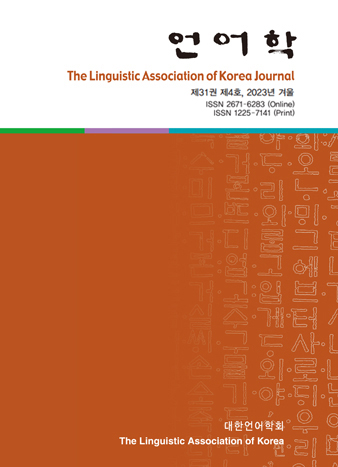대한언어학회 전자저널

31권 4호 (2023년 12월)
- Bound Noun pep in Korean
-
Tae Sik Kim
Pages : 113-136
Abstract
Kim, Tae Sik. (2023). Bound noun pep in Korean. The Linguistic Association of Korea Journal, 31(4), 113-136. This paper discusses the syntactic analysis of a bound noun pep in Korean. Song and Kim (2014) categorize four different meanings of pep law, way/how.to, conjecture/speculation and naturalness. They assume that the latter two meanings form a bound-noun-complex with the following restricted verbs (e.g., a copular verb i and a light verb ha). However, the seemingly morphological and syntactic characteristics of the target structures are not due to the bound noun pep but due to the following verbs (the copular and the light verb). Also, the restrictions are not limited to the bound noun pep. In this paper, I argue that there are three different structures with the bound noun pep based on its different meanings: i) it merges in N like normal nouns; ii) it also merges in N, subsequently moves to small n, and ultimately moves to ModEPIS; iii) it can be a head of C. Given that grammaticalization tends to go upward in a syntactic tree (Roberts and Roussou 2003, van Gelderen 2004), the proposal leads us to conclude that the bound noun pep is highly grammaticalized compared to other bound nouns
Keywords
# bound noun # grammaticalization # pep # nominal # complementizer
References
- Ahn, H.-K. (2001). Hyentaykwukeuy uyconmyengsa yenkwu (‘A study on bound nouns in Present-Day Korean’). Seoul: Youkrack Pblishing.
- Choe, H.-S. (1988). Restructuring Parameters and Comlex Predicates; A Transformational Approach. Doctoral Dissertation. MIT.
- Ha, I.-J. (2007). NPI Licensing in Korean Modal Constructions. Japanese/Korean Linguistics, 15, 312-323
- Hopper, P. J., & Traugott, E. (2003). Grammaticalization. Cambridge: Cambridge University Press.
- Kim, T.-S. (2016). Bound Nouns, Ellipsis or Pro-form?. Studies in Generative Grammar 26(1), 1-14.
- Kim, T.-S. (2017). The Relationship between Semantic Bleaching and Syntax: A Case from Bound Noun cwung in Korean. Studies in Generative Grammar 27(3), 565-589.
- Kim, T.-S. (2021). Bound Noun kes in Korean, revisited. Studies in Generative Grammar, 31(3), 357-379.
- Palmer, F. R. (2001). Mood and modality (2nd ed.). Cambridge: Cambridge University Press.
- Roberts, I., & Roussou, A. (2003). Syntactic Change: A Minimalist Approach to Grammaticalization. Cambridge, NY: Cambridge University Press.
- Sohn, K.-W. (1996). Negative Polarity items, Scope, and Economy. Seoul: Thayhaksa.
- Song, D.-H., & Kim, H.-S. (2014). Hancae myengsa 'pep'uy mwunpephwa yangsang yenkwu (‘A Study on the Aspects of Grammaticalization of Sino-Korean Noun ’Beop’‘). Studies in Linguistics, 33, 175-195.
- van Gelderen, E. (2004). Grammaticalization as Economy. Amsterdam: John Benjamins.